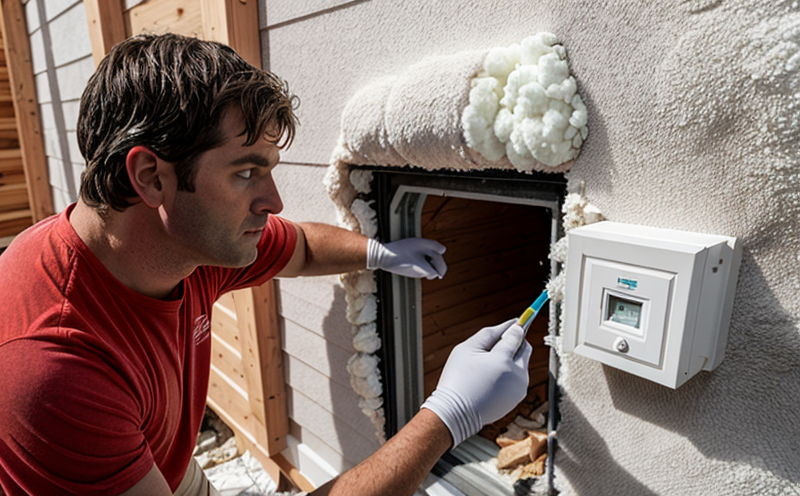EN 12664 Heat Transfer Measurement in Building Components
The European standard EN 12664 specifies methods for determining the thermal transmittance (U-value) of building components, including walls, roofs, and floors. This is crucial for ensuring energy efficiency and compliance with environmental standards such as the EU’s Energy Performance of Buildings Directive (EPBD).
Accurate heat transfer measurement helps architects, engineers, and construction professionals design buildings that are not only functional but also environmentally sustainable. By measuring U-values according to EN 12664, you can ensure your project meets regulatory requirements while optimizing energy performance.
The standard is particularly important for specifying insulation materials and ensuring they perform as expected in real-world conditions. This includes understanding how different factors—such as air movement, water vapor diffusion, or solar radiation—affect the thermal properties of building components. The test results can guide decisions on material selection and installation practices to enhance overall performance.
EN 12664 encompasses various techniques for measuring heat transfer, including steady-state methods (ISO 9869) and transient methods (ISO 13795). Each method has its own strengths and is suitable under different circumstances. For instance, the steady-state method measures thermal transmittance when a component reaches thermal equilibrium, while transient methods assess performance over time.
The standard also provides guidelines for preparing specimens and conducting tests in controlled environments to ensure accurate measurement of U-values. Specimens are often tested using calorimetric equipment designed specifically for this purpose. The results provide insights into the actual energy efficiency of a building component under specified conditions, which is critical for meeting sustainability goals.
Understanding how materials behave under different environmental conditions is essential for reliable testing. Factors like humidity and air movement can significantly impact thermal performance. Therefore, it's important to consider these variables when specifying insulation materials and designing buildings that meet both functional and regulatory requirements.
| Measurement Technique | Description | Applicability |
|---|---|---|
| Steady-State Method (ISO 9869) | The component is tested in a steady-state condition where the temperature difference between the inner and outer surfaces remains constant. | Most suitable for simple components with stable conditions. |
| Transient Method (ISO 13795) | The performance of the component is evaluated over time as it transitions from one steady state to another. | Useful for complex systems and dynamic environments. |
In addition to U-value, EN 12664 also covers other parameters such as air tightness (EN 13829) and solar heat gain coefficient (SHGC). These additional metrics provide a comprehensive picture of the thermal performance of building components.
The standard is widely recognized across Europe and beyond for its robust methodology. Compliance with EN 12664 ensures that your project meets stringent quality standards and contributes to sustainable development goals. By adhering to this standard, you can ensure that your buildings are both energy-efficient and environmentally friendly.
Scope and Methodology
The scope of EN 12664 covers the determination of thermal transmittance (U-value) for building components. This includes walls, roofs, floors, doors, windows, and other elements that contribute to a building's overall thermal performance.
Steady-State Method: This method measures the heat transfer through a component under steady-state conditions. It is suitable for simple components where temperature differences between the inner and outer surfaces are maintained consistently.
Transient Method: This method evaluates the thermal behavior of a component over time as it transitions from one steady state to another. It is useful for complex systems that experience dynamic changes in environmental conditions.
The methodology involves preparing specimens, placing them in controlled environments, and measuring heat flow using calorimetric equipment. The results provide valuable insights into the thermal performance of building components under specified conditions.
Benefits
Ensures compliance with European standards for energy efficiency in buildings.
Provides accurate data on thermal transmittance (U-value) to guide material selection and design decisions.
Reduces the risk of regulatory non-compliance by ensuring that building components meet specified performance criteria.
Contributes to sustainable development goals by promoting energy-efficient construction practices.
Improves the overall comfort and well-being of occupants in buildings with optimized thermal performance.
Simplifies procurement processes by providing clear specifications for insulation materials and building components.
The results from EN 12664 testing can also be used to benchmark performance against industry best practices, helping to drive continuous improvement in the construction sector.
International Acceptance and Recognition
EN 12664 is widely recognized across Europe and beyond for its rigorous methodology. Compliance with this standard ensures that building components meet stringent quality standards and contribute to sustainable development goals. The test results can be used in international contexts, providing a common language for discussing thermal performance.
The standard's recognition extends beyond Europe to countries around the world that adhere to European Union directives or have similar regulations regarding energy efficiency in buildings. This global acceptance enhances interoperability between different regions and fosters collaboration on sustainable construction practices.
By adhering to EN 12664, you can ensure that your project meets regulatory requirements while optimizing energy performance. The standard's widespread adoption also reflects a commitment to environmental responsibility and long-term cost savings for building owners and operators.





